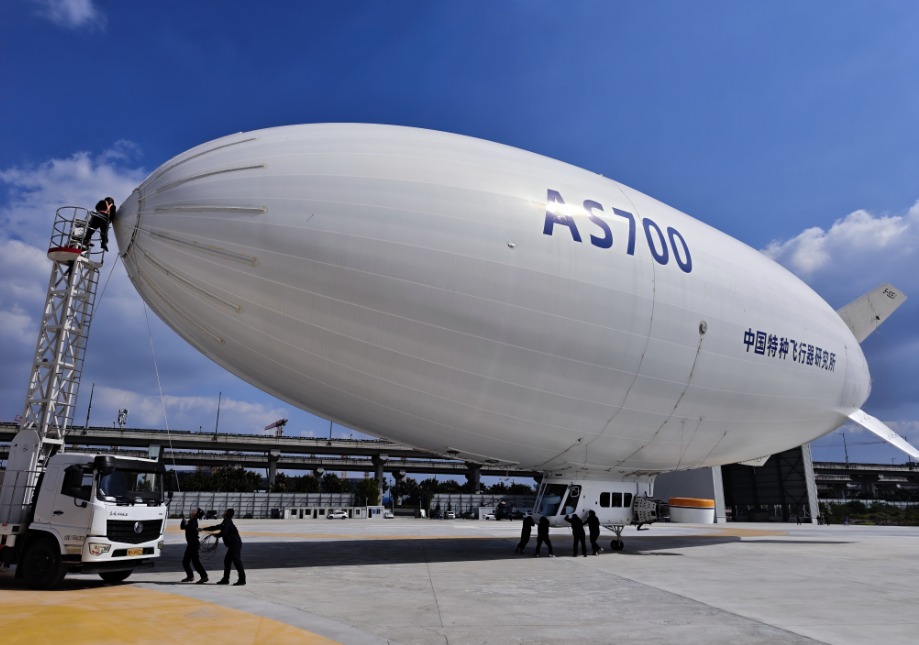Support CleanTechnica’s work through a Substack subscription or on Stripe.
Last year’s commercial introduction of the locally-developed manned airship, the AS700, was the start of what China calls its low-altitude economy. America calls it the blimp economy.
News agency Xinhua reported how the ten-seater airship was first delivered by the Aviation Industry Corporation of China (AVIC) to Guangxi Guilin Ark General Aviation Co., Ltd. in Yangshuo County in September 2024, for a long period of testing to confirm the airship’s operational readiness and get its airworthiness certification.
Last October this year, the Xiangyun, meaning “Auspicious Cloud,” was successfully tested in its first manned flight, immediately positioning it as a novel option for low-altitude sightseeing tours over famous landscapes like the ink painting-like karst scenery of Guilin.
The delivery of the AS700 serves as a tangible manifestation of a national strategic shift.
Getting Low
The Central Committee of the Communist Party of China has mandated the development of the low-altitude economy — defined as commercial activity in the airspace generally below 1,000 meters — as a new growth engine. This high-level policy support has been adopted across more than twenty Chinese provinces and regions, which are accelerating the establishment of local policies and infrastructure to capture a share of the burgeoning sector.
Forecasts from industry authorities reflect this momentum, estimating the size of the low-altitude economy, which includes drone logistics, general aviation, and new transport systems like air taxis, is expected to surge past two trillion yuan by 2030.
Also what else could be greener than a blimp?

America’s Low Altitude Blimps
I just have to give one or two paragraphs on what fascinated me since I first saw it live in 2009 — The Goodyear Blimp. The US Army’s use of non-rigid airships for coastal patrol began in the early 1900s. The Navy developed its own anti-submarine blimps during World War I, with Goodyear becoming a major manufacturer for both the military and a commercial fleet, which began in 1925 with the Pilgrim. Blimps have since been used for military surveillance and became iconic as advertising tools.
The Goodyear blimp began making its presence in public events covering its first Rose Bowl in 1955 and the first Super Bowl in 1967. In 2014, Goodyear began replacing its traditional non-rigid blimps with a new, semi-rigid design built by Zeppelin Luftschifftechnik. “Goodyear Zeppelin” didn’t roll off the tongue as well as “Goodyear Blimp.” The lovely term was never retracted.
Ooops, It’s Not As Green As I Thought
As the AS700 is powered by a gasoline-fed engine, it may not deserve space here.
Hear me out first. As the Auspicious Cloud program transitions to full commercial operation, with substantial confirmed orders driving AVIC to increase its production capacity, the airship’s role is expanding beyond its initial focus on tourism.
Developers are actively planning to introduce the platform for a wide array of public service applications, including aerial advertising, urban security patrols, infrastructure surveying, and critical emergency rescue operations. This versatility aligns with the government’s goal of leveraging new aircraft to transform urban management and logistics.
Fortunately, the AS700 has a new “D” version that is powered by electricity.
The AS700D features a comprehensive electrification upgrade. This all-electric airship uses a lithium battery-powered drive system, yielding the benefits of near-zero emissions and significantly reduced operational noise. While this electric configuration leads to a lower maximum speed of 80 kilometers per hour compared to the standard model’s 100 kilometers per hour, the compromise is deliberate.
The AS700D is engineered to provide a quieter, smoother flight experience, making it particularly suitable for deployment in ecologically sensitive nature reserves, areas with strict noise regulations, and around large public gatherings like marathons or concerts.
This development underscores the manufacturer’s commitment to providing a series of intelligent and eco-friendly airships, cementing the Auspicious Cloud family as a key platform in the modernization of China’s low-altitude airspace.
Sign up for CleanTechnica’s Weekly Substack for Zach and Scott’s in-depth analyses and high level summaries, sign up for our daily newsletter, and follow us on Google News!
Have a tip for CleanTechnica? Want to advertise? Want to suggest a guest for our CleanTech Talk podcast? Contact us here.
Sign up for our daily newsletter for 15 new cleantech stories a day. Or sign up for our weekly one on top stories of the week if daily is too frequent.
CleanTechnica uses affiliate links. See our policy here.
CleanTechnica’s Comment Policy



